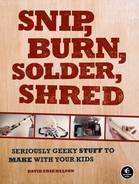Invented in China roughly 2,000 years ago, silk screen printing is the cheapest, most pleasing way to directly reproduce images and designs. A screen (once silk, now usually polyester, but in all cases permeable to ink) is stretched over a wooden frame, and screen filler is applied to all portions of the screen that are not part of the intended design, forming a stencil. (The Chinese used to do this by weaving human hairs into the screen in order to make portions impermeable.) Once the filler has dried, you apply ink to the screen and pull the ink across the open design with a squeegee, flooding the mesh and pressing through onto your substrate (usually paper or cloth). You then repeat this process, adding more ink as necessary. Using this technique, hundreds of copies of a single design can be more or less perfectly reproduced in about an hour.
Beginner screen printing kits are a little pricey and are not necessary to get a feel for the method. There’s nothing magical about the “silk” mesh used on commercial screens, apart from being very fine and sturdy. Any mesh will do. Nylon tulle (used to make veils, wedding centerpieces, etc.) is cheap (a few bucks a yard), sold at any craft or fabric store, and works fine. Your prints will end up a little lo-fi (sort of blocky, è la Super Mario), so you might prefer a finer mesh; fabric stores have bolts of mesh backing materials used in dressmaking, such as organdy or organza. Avoid anything with much stretch to it, like old nylon stockings, as these will distort easily as you work the screen. I made my first screens from fabric scrounged from grimy old negligees a friend found while cleaning out her dearly departed granny’s house. Worked like a charm.
The screen frame is, likewise, nothing special. We’ll use an embroidery hoop in this project, since they are essentially free at many garage sales and cost less than $1.50 brand new. Old picture frames or the frames from recessed metal light fixtures also work well, or you can build frames from scrap wood.
Most commercial screen fillers can be washed out with solvent, and the screens reused with new designs. Our screen filler can’t be washed out—meaning that you can only use each screen for a single design—but it should weather repeated gentle washes, making limited mass production possible; it’s perfect for adding a repeating motif to your PVC Teepee (see Chapter 4).

